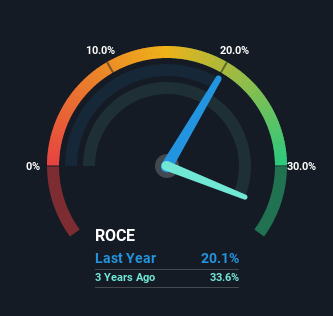What trends should we look for it we want to identify stocks that can multiply in value over the long term? Amongst other things, we'll want to see two things; firstly, a growing return on capital employed (ROCE) and secondly, an expansion in the company's amount of capital employed. If you see this, it typically means it's a company with a great business model and plenty of profitable reinvestment opportunities. Having said that, while the ROCE is currently high for V-MARC India (NSE:VMARCIND), we aren't jumping out of our chairs because returns are decreasing.
Understanding Return On Capital Employed (ROCE)
If you haven't worked with ROCE before, it measures the 'return' (pre-tax profit) a company generates from capital employed in its business. The formula for this calculation on V-MARC India is:
Return on Capital Employed = Earnings Before Interest and Tax (EBIT) ÷ (Total Assets - Current Liabilities)
0.20 = ₹169m ÷ (₹1.9b - ₹1.1b) (Based on the trailing twelve months to September 2022).
So, V-MARC India has an ROCE of 20%. That's a fantastic return and not only that, it outpaces the average of 15% earned by companies in a similar industry.
See our latest analysis for V-MARC India

While the past is not representative of the future, it can be helpful to know how a company has performed historically, which is why we have this chart above. If you're interested in investigating V-MARC India's past further, check out this free graph of past earnings, revenue and cash flow.
SWOT Analysis for V-MARC India
- Earnings growth over the past year exceeded its 5-year average.
- Debt is well covered by cash flow.
- Earnings growth over the past year underperformed the Electrical industry.
- Interest payments on debt are not well covered.
- Trading below our estimate of fair value by more than 20%.
- Lack of analyst coverage makes it difficult to determine VMARCIND's earnings prospects.
- No apparent threats visible for VMARCIND.
What Can We Tell From V-MARC India's ROCE Trend?
In terms of V-MARC India's historical ROCE movements, the trend isn't fantastic. To be more specific, while the ROCE is still high, it's fallen from 34% where it was five years ago. However, given capital employed and revenue have both increased it appears that the business is currently pursuing growth, at the consequence of short term returns. If these investments prove successful, this can bode very well for long term stock performance.
On a related note, V-MARC India has decreased its current liabilities to 56% of total assets. That could partly explain why the ROCE has dropped. Effectively this means their suppliers or short-term creditors are funding less of the business, which reduces some elements of risk. Some would claim this reduces the business' efficiency at generating ROCE since it is now funding more of the operations with its own money. Either way, they're still at a pretty high level, so we'd like to see them fall further if possible.
In Conclusion...
In summary, despite lower returns in the short term, we're encouraged to see that V-MARC India is reinvesting for growth and has higher sales as a result. Furthermore the stock has climbed 81% over the last year, it would appear that investors are upbeat about the future. So while investors seem to be recognizing these promising trends, we would look further into this stock to make sure the other metrics justify the positive view.
If you'd like to know more about V-MARC India, we've spotted 4 warning signs, and 2 of them are potentially serious.
High returns are a key ingredient to strong performance, so check out our free list ofstocks earning high returns on equity with solid balance sheets.
New: Manage All Your Stock Portfolios in One Place
We've created the ultimate portfolio companion for stock investors, and it's free.
• Connect an unlimited number of Portfolios and see your total in one currency
• Be alerted to new Warning Signs or Risks via email or mobile
• Track the Fair Value of your stocks
Have feedback on this article? Concerned about the content? Get in touch with us directly. Alternatively, email editorial-team (at) simplywallst.com.
This article by Simply Wall St is general in nature. We provide commentary based on historical data and analyst forecasts only using an unbiased methodology and our articles are not intended to be financial advice. It does not constitute a recommendation to buy or sell any stock, and does not take account of your objectives, or your financial situation. We aim to bring you long-term focused analysis driven by fundamental data. Note that our analysis may not factor in the latest price-sensitive company announcements or qualitative material. Simply Wall St has no position in any stocks mentioned.
About NSEI:VMARCIND
V-MARC India
Manufactures and markets electrical wires and cables under the V-Marc brand name in India.
Mediocre balance sheet with low risk.
Similar Companies
Market Insights
Community Narratives



